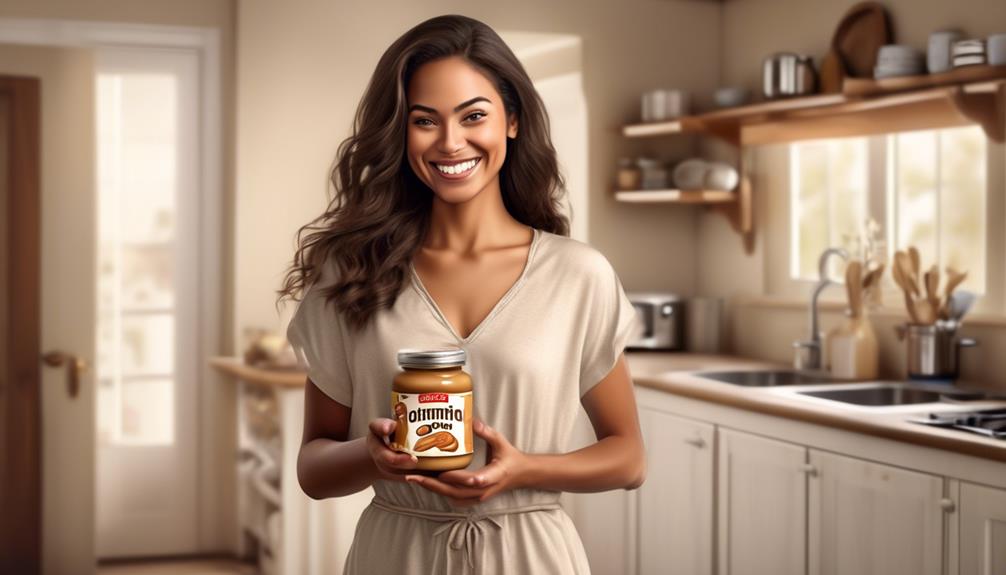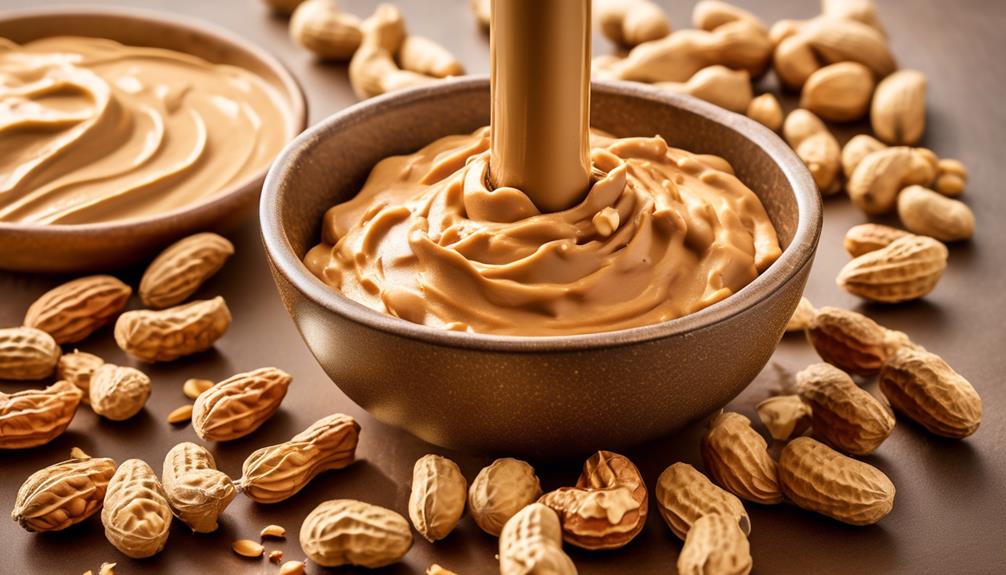You know what they say, 'An ounce of prevention is worth a pound of cure.' When it comes to military medical procedures, one term that often sparks curiosity is the 'peanut butter shot.'
It's not your typical jar of Skippy; instead, it's an injection with a consistency reminiscent of the beloved spread. But what exactly is this shot, and why is it referred to as 'peanut butter'?
Well, there's more to it than meets the eye, and understanding its significance in the military world might just surprise you.
Key Takeaways
- The peanut butter shot is a thick bicillin medication injected into recruits during boot camp medical processing to protect against bacterial illnesses.
- The injection is administered by trained medical staff in the buttocks, and the slow absorption of the medication can lead to discomfort and the formation of a painful lump.
- The injection is an essential preventive measure for military personnel and is part of the standard procedure during military medical evaluations.
- There are common misconceptions about the injection, including beliefs that it is unnecessary, has severe side effects, and is given for punitive or hazing reasons. However, the injection is solely for the health and well-being of the recruits.
The Origin of the Peanut Butter Shot
How did the term 'peanut butter shot' originate in reference to the bicillin vaccination given to recruits in the military?
The origin of the term 'peanut butter shot' stems from the thick, peanut butter-like consistency of the bicillin medication injected into the butt cheek of recruits during boot camp medical processing.
This slang term was likely coined by recruits themselves due to the striking resemblance of the medication to peanut butter. The injection, administered by medical staff as a routine part of the processing, is a necessary step to protect recruits from bacterial illnesses.
Despite its painful aftermath, the peanut butter shot is a crucial component of the 17 required vaccinations for military personnel. The slow absorption rate of the medication leads to the formation of a painful lump, making it uncomfortable for recruits to sit or move for a few days.
Despite the discomfort, the peanut butter shot remains an essential measure to ensure the well-being of recruits and maintain the health and readiness of military personnel.
Administration of the Injection

When it comes to the administration of the peanut butter shot, it's important to understand the injection procedure overview, the injection site preparation, and the needle insertion technique.
These are crucial aspects that contribute to the overall experience and effectiveness of the vaccination. Understanding the details of how the shot is administered can provide valuable insights into the process and its impact on individuals receiving it.
Injection Procedure Overview
Administering the peanut butter shot involves injecting the bicillin vaccination into the buttocks and is a standard procedure during military medical evaluations in boot camp.
The injection procedure overview includes:
- Medical Staff: Trained professionals administer the shot to recruits, ensuring proper technique and minimizing discomfort.
- *Physical Movement*: Recruits are instructed to relax their muscles during the injection to reduce pain and facilitate the process.
The thick needle and slow absorption of the medication contribute to the shot's notoriety, but it remains a crucial preventive measure against bacterial infections. Despite the initial discomfort, the lasting protection it offers makes it an essential part of the medical evaluation process in boot camps.
Injection Site Preparation
To ensure a clean, hygienic environment, the first step in injection site preparation is to verify that the area is clean, dry, and free of any visible injuries or skin conditions.
Proper identification of the correct injection site is crucial, and medical staff must use proper hand hygiene to minimize the risk of introducing bacteria into the body.
It's essential to remove any potential barriers to access the injection site, such as tight clothing, to ensure a smooth and accurate administration of the injection.
After administering the peanut butter shot, proper disposal of any used materials and cleaning up the area is crucial to maintaining a hygienic environment.
Effective communication with the individual receiving the injection, explaining the procedure, and addressing any concerns is also important.
This thorough injection site preparation is essential for successful medical evaluations, especially in settings like boot camps where physical movement is rigorous.
Needle Insertion Technique
Properly preparing the injection site is crucial for ensuring a clean and hygienic environment, and this includes the needle insertion technique for administering the peanut butter shot.
When medical staff administer the injection, they follow a specific technique to ensure the medication is properly delivered into the muscle. This involves using a long and thick needle to inject the medication into the recruits' butt cheeks.
The recruits are instructed to pull down their trousers, reveal one buttock, and bend over while transferring weight to one leg for the injection. This technique ensures deep intramuscular absorption of the medication and minimizes the risk of nerve or artery damage during administration.
It's important for recruits to relax during the injection to minimize discomfort and soreness at the injection site.
Physical Sensations and Reactions

Experiencing soreness and discomfort, many recruits dread receiving the peanut butter shot during their military processing week. The physical sensations and reactions to this injection can be quite intense. The thick needle and the peanut butter-like consistency of the medication contribute to the painful nature of the shot. After the injection, recruits often report immediate discomfort at the injection site. The slow absorption rate of the medication can also lead to prolonged pain, causing a painful lump to develop. This reaction is a source of anxiety for many recruits.
The medical staff is well aware of the challenging nature of the peanut butter shot and often provide support and guidance to help recruits manage the physical sensations and reactions. Despite the painful aspects of this vaccination, it's considered essential for protecting recruits from potential bacterial infections during their time at boot camp. While the peanut butter shot may be a source of apprehension, the medical staff strives to ensure that recruits receive necessary care and support during the process.
Purpose and Benefits of the Shot

Despite the discomfort and anxiety often associated with the peanut butter shot, understanding its purpose and benefits is crucial for recruits undergoing military processing.
- Preventive Measure:
The peanut butter shot, or bicillin vaccination, serves as a preventive measure against bacterial infections that recruits may be exposed to during their training in boot camps. The slow absorption rate of the medication provides prolonged effectiveness, offering valuable protection to the recruits during their rigorous training.
- Standard Procedure:
The injection is a standard part of the medical evaluation process in boot camp, ensuring the overall health and well-being of the recruits. While the shot may cause temporary discomfort, its benefits in providing broad-spectrum protection outweigh the transient physical sensations.
Understanding the purpose and benefits of the peanut butter shot can help recruits appreciate its significance in safeguarding their health during their military training. The injection plays a vital role in protecting individuals from potential infections, allowing them to focus on their physical movement and training without the worry of falling ill.
The Peanut Butter Shot in Military Training

The bicillin vaccination, colloquially known as the peanut butter shot, is an integral component of the medical evaluation process for recruits in military training. This injection, while effective in protecting recruits from bacterial illnesses, is infamous for the discomfort it causes.
Administered in the buttocks, its slow absorption often leads to a painful lump, impacting recruits' ability to sit and move comfortably for a few days. This can be particularly challenging during the physically demanding activities of boot camp. Recruits often fear this shot due to its painful aftermath, but despite the discomfort, it remains a necessary part of the medical evaluation process.
Exemptions are only made for those with proven allergies to the medication, who must provide evidence to avoid the vaccination. Although unpleasant, the peanut butter shot serves as an introduction to the challenges faced in the military, preparing recruits for the rigors ahead.
Common Misconceptions About the Injection

What are some common misconceptions about the peanut butter shot?
- Misconception 1: The injection is unnecessary and doesn't provide any real benefit to recruits.
- Misconception 2: The side effects of the peanut butter shot are severe and long-lasting, causing significant harm to the recipients.
It's important to address some common misconceptions about the peanut butter shot.
Firstly, some individuals may believe that the injection is unnecessary and doesn't provide any real benefit to recruits. However, the peanut butter shot, despite being painful, is considered effective in protecting recruits from bacterial illnesses.
Secondly, there's a misconception that the side effects of the peanut butter shot are severe and long-lasting, causing significant harm to the recipients. While the injection may cause discomfort and impact recruits' daily activities for a few days, the side effects are typically temporary and don't result in long-term harm.
Understanding the facts about the peanut butter shot is crucial in dispelling these misconceptions and providing recruits with accurate information about the vaccination process in military training.
Evolution and Changes Over Time

Over time, the peanut butter shot has undergone changes and adaptations, reflecting advancements in medical technology and scientific research.
The historical origins of the vaccination, ingredient adaptations, and modern flavor variations are significant aspects to explore in understanding its evolution.
These points shed light on the development of the peanut butter shot and its impact on medical practices.
Historical Origins
In the evolution of military medical protocols, the administration of the bicillin vaccination, colloquially known as the peanut butter shot, has remained a consistent practice during recruit processing week.
This thick liquid injection has been a standard procedure for decades, reflecting the military's commitment to ensuring the health and well-being of its recruits. The use of bicillin as a vaccination demonstrates the military's dedication to protecting new recruits from various illnesses that could compromise their training.
Additionally, the persistence of this practice highlights the trust that medical staff have in the effectiveness of the vaccination. Over time, the peanut butter shot has become an integral part of the initiation process for recruits, symbolizing the military's ongoing efforts to prioritize the health and readiness of its personnel.
Ingredient Adaptations
The historical use of the peanut butter shot in military medical protocols has led to adaptations in its ingredients over time, reflecting advancements in medical science and evolving health considerations for recruits.
These adaptations focus on minimizing discomfort and potential side effects for the recruits. Medical staff continuously work on improving the injection's consistency and absorption rate to reduce the pain experienced during and after the vaccination.
Additionally, advancements in medication formulations aim to enhance the shot's effectiveness while reducing the formation of painful lumps in the muscle.
These changes align with the military's commitment to the well-being of its recruits, acknowledging the physical and psychological challenges they face during boot camp.
The evolution of the peanut butter shot's ingredients underscores the ongoing efforts to ensure the health and safety of military personnel.
Modern Flavor Variations
With advancements in medical research and technology, the modern variations of the peanut butter shot have undergone significant evolution to enhance effectiveness and reduce discomfort for military recruits.
- Improved Formulation
- Medical staff have developed formulations with enhanced absorption rates, reducing the discomfort and immobility experienced by recruits after receiving the injection.
- This has allowed recruits to resume physical movement more quickly, minimizing the impact on their training and daily activities.
The modern peanut butter shot variations aim to maintain the effectiveness of the medication while prioritizing the well-being of the recruits, addressing their concerns about pain and immobility.
These advancements demonstrate the commitment to continuously improving the administration of essential vaccinations in boot camps.
Personal Experiences With the Peanut Butter Shot

Experiencing the peanut butter shot during military boot camp was a challenging and uncomfortable introduction to the medical procedures of military life.
Our time in boot camp was marked by the looming dread of the peanut butter shot. When the medical staff administered the injection, the thick, slow-absorbing medication caused intense discomfort, making sitting and physical movement painful for several days. Many of us struggled with the aftermath of the shot, finding it difficult to perform daily activities. It served as a stark realization of the sacrifices and challenges inherent in military life.
While the pain was undeniable, we understood the importance of the vaccination in safeguarding our health. Witnessing the diverse reactions of fellow recruits also highlighted the individual nature of the experience. Despite the discomfort, the peanut butter shot was a necessary, albeit unwelcome, part of our introduction to military medical procedures.
Frequently Asked Questions
What Exactly Is the Peanut Butter Shot?
It's a vaccination given to military recruits during boot camp medical evaluations. The medication, with a thick, peanut butter-like consistency, is administered in the butt cheek to prevent bacterial infections. Despite causing pain and discomfort, it's a standard procedure.
The experience can impact recruits' daily activities and is memorable as an introduction to military medical procedures. Despite its unpleasantness, it serves an essential purpose in maintaining the well-being of military personnel.
What Is the Peanut Butter Shot Slang?
The peanut butter shot is a nickname for the bicillin vaccine given to military recruits during boot camp. It's called this due to its thick, peanut butter-like consistency.
This vaccination is effective, providing broad-spectrum protection from bacterial illnesses. Despite its benefits, it's feared for the pain it causes. Nearly all recruits receive it, unless allergic.
The pain can affect daily activities, but it's a necessary part of the evaluation process.
Why Does the Military Give Penicillin Shots?
The military gives penicillin shots to prevent bacterial infections among recruits. These shots, often nicknamed 'peanut butter shots,' are administered during processing week to provide broad-spectrum protection.
While they may cause discomfort due to the thick liquid and painful lump it creates, the shots are considered necessary for the medical evaluation process in boot camp.
The purpose is to ensure recruits remain healthy and free from preventable infections during their training.
Can You Be Exempt From the Peanut Butter Shot?
Yes, recruits can be exempt from the peanut butter shot if they've a proven allergy to the medication. Evidence of the allergy must be provided.
The peanut butter shot, administered in the butt cheek, is feared due to its pain and slow absorption rate. This exemption is important as the shot's discomfort can impact daily activities.
It's a necessary part of the medical evaluation process in boot camp, but recruits with allergies are exempt.
Conclusion
In conclusion, the peanut butter shot is a necessary part of military training, despite its notorious reputation.
Like the saying goes, 'no pain, no gain.'
While the injection may cause discomfort, it serves a valuable purpose in protecting the health of recruits.
Understanding the origin, administration, and benefits of the shot can help dispel misconceptions and prepare individuals for their military journey.










